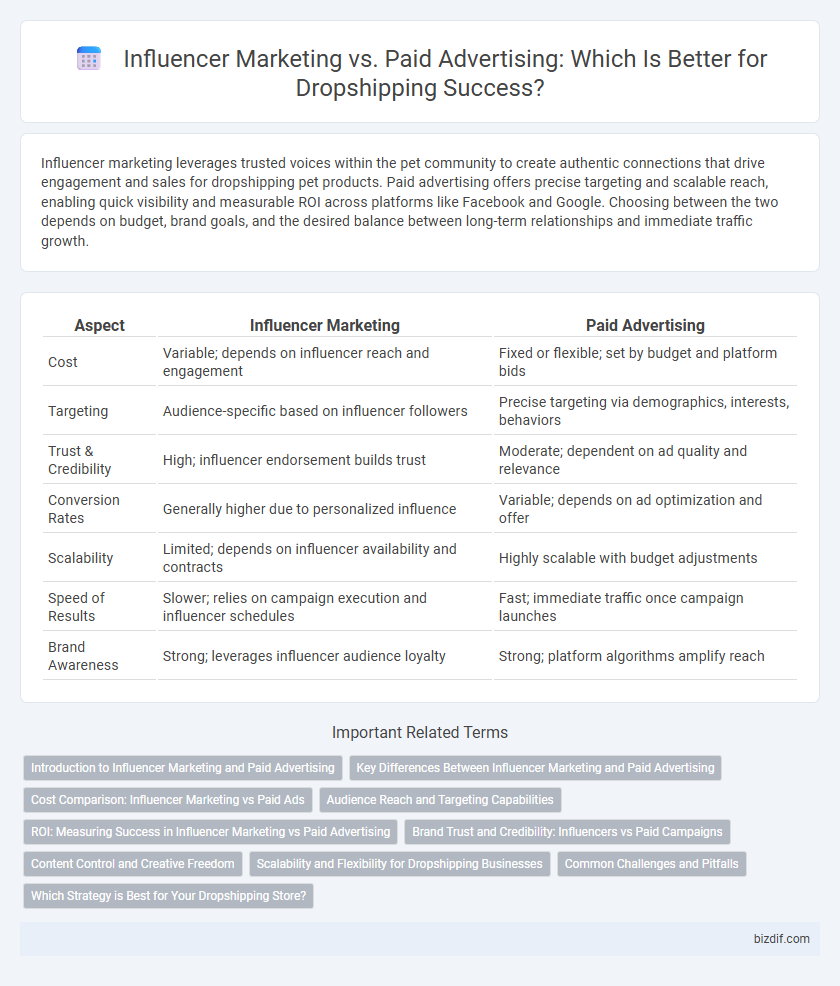Influencer marketing leverages trusted voices within the pet community to create authentic connections that drive engagement and sales for dropshipping pet products. Paid advertising offers precise targeting and scalable reach, enabling quick visibility and measurable ROI across platforms like Facebook and Google. Choosing between the two depends on budget, brand goals, and the desired balance between long-term relationships and immediate traffic growth.
Table of Comparison
| Aspect | Influencer Marketing | Paid Advertising |
|---|---|---|
| Cost | Variable; depends on influencer reach and engagement | Fixed or flexible; set by budget and platform bids |
| Targeting | Audience-specific based on influencer followers | Precise targeting via demographics, interests, behaviors |
| Trust & Credibility | High; influencer endorsement builds trust | Moderate; dependent on ad quality and relevance |
| Conversion Rates | Generally higher due to personalized influence | Variable; depends on ad optimization and offer |
| Scalability | Limited; depends on influencer availability and contracts | Highly scalable with budget adjustments |
| Speed of Results | Slower; relies on campaign execution and influencer schedules | Fast; immediate traffic once campaign launches |
| Brand Awareness | Strong; leverages influencer audience loyalty | Strong; platform algorithms amplify reach |
Introduction to Influencer Marketing and Paid Advertising
Influencer marketing leverages social media personalities to promote dropshipping products, enhancing brand trust and targeting niche audiences through authentic content. Paid advertising utilizes platforms like Google Ads and Facebook Ads to drive immediate traffic and sales via precise targeting and budget control. Both strategies optimize dropshipping growth but differ in approach, cost structure, and audience engagement.
Key Differences Between Influencer Marketing and Paid Advertising
Influencer marketing leverages authentic content creation and community trust by collaborating with individuals who have established audiences, resulting in higher engagement and brand loyalty. Paid advertising relies on targeted campaigns with precise demographic data to maximize reach and immediate conversions through platforms like Google Ads or Facebook Ads. Influencer marketing often drives long-term brand awareness, whereas paid advertising typically focuses on short-term sales performance and measurable ROI.
Cost Comparison: Influencer Marketing vs Paid Ads
Influencer marketing typically offers a lower upfront cost compared to paid advertising, often relying on product exchanges or negotiated fees based on audience reach and engagement rates. Paid ads require continuous investment with costs directly tied to click-through rates, impressions, and conversion goals, which can escalate quickly without guaranteed returns. Brands often find influencer campaigns yield higher organic engagement at a more controlled budget, whereas paid ads provide scalable but potentially more expensive traffic acquisition.
Audience Reach and Targeting Capabilities
Influencer marketing leverages authentic connections with niche audiences, enabling precise targeting through influencer demographics and follower engagement metrics ideal for dropshipping brands seeking specific customer segments. Paid advertising offers scalable reach across platforms like Facebook and Google, with advanced targeting options including interests, behaviors, and retargeting, optimizing ad spend efficiency. Combining both strategies enhances audience reach and precision targeting, driving higher conversion rates in competitive dropshipping markets.
ROI: Measuring Success in Influencer Marketing vs Paid Advertising
Influencer marketing often delivers higher ROI in dropshipping due to authentic customer engagement and targeted audience reach, boosting conversion rates. Paid advertising provides immediate traffic but frequently incurs higher costs per acquisition, reducing overall profitability. Measuring success requires analyzing metrics like cost per conversion, customer lifetime value, and return on ad spend (ROAS) for both strategies.
Brand Trust and Credibility: Influencers vs Paid Campaigns
Influencer marketing enhances brand trust and credibility by leveraging authentic endorsements from trusted personalities, resulting in higher consumer confidence and engagement. Paid advertising often appears more promotional, which can lead to skepticism and lower perceived authenticity among potential customers. Brands investing in influencer collaborations typically experience stronger brand loyalty and sustained customer relationships compared to those relying solely on paid campaigns.
Content Control and Creative Freedom
Influencer marketing offers limited content control as brands rely on influencers' personal style and audience engagement, resulting in authentic but less predictable messaging. Paid advertising provides complete creative freedom, enabling precise targeting and strict control over ad content to align with brand guidelines and campaign goals. Dropping businesses often balance both methods, leveraging influencer authenticity with paid ads' scalable control to optimize customer reach and brand consistency.
Scalability and Flexibility for Dropshipping Businesses
Influencer marketing offers scalable growth for dropshipping businesses by leveraging niche audiences with high engagement and authentic product endorsements, often resulting in better conversion rates and long-term brand loyalty. Paid advertising provides greater flexibility through targeted campaigns and real-time adjustments, allowing businesses to quickly test different markets, optimize ad spend, and scale rapidly based on performance metrics like CPC and ROI. Balancing influencer partnerships with data-driven paid ads enables dropshipping brands to maximize reach and adapt to evolving market demands efficiently.
Common Challenges and Pitfalls
Influencer marketing and paid advertising in dropshipping both face challenges such as targeting the right audience effectively and managing budgets efficiently to maximize ROI. Influencer campaigns often struggle with authenticity issues and inconsistent engagement metrics, while paid advertising risks ad fatigue and increased costs due to competitive bidding environments. Both strategies require continuous monitoring and optimization to avoid wasted spend and ensure scalable growth.
Which Strategy is Best for Your Dropshipping Store?
Influencer marketing leverages authentic audience trust and engages niche communities, often yielding higher conversion rates for dropshipping stores with targeted products. Paid advertising offers scalable traffic and precise demographic targeting, allowing rapid testing and optimization of ads across platforms like Facebook and Google. Choosing the best strategy depends on budget constraints, brand identity, and long-term goals, with many successful dropshippers combining both for maximum reach and ROI.
Influencer Marketing vs Paid Advertising Infographic

 bizdif.com
bizdif.com